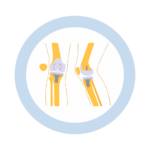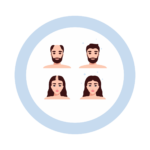Arthroscopy in Mumbai
Arthroscopy
Meditore Mumbai
Approved Procedures
Painless* Procedures
Insurance Paperwork Support
Day Care
Procedure
What is Arthroscopy?
Arthroscopy is a procedure used for joint conditions. Originally, arthroscopy was used mainly for planning a standard open surgery. But with new tools and advanced surgical methods, many conditions can also be treated using an arthroscope. Meditore has the most experienced surgeon for the treatment of arthroscopy in mumbai with the advanced equipment’s and facilities we make your surgery painless and worry-free. Get in touch with us to know more and for consultation
Let's Schedule Your Appointment
Arthroscopy is a minimally invasive procedure used to diagnose, assess, and treat conditions in the joints of the body. The procedure is performed using an arthroscope which is inserted through small incisions in the skin. The arthroscope is inserted into the joint space to explore the condition of the cartilage, tendons, ligaments and other tissues in that area. Light is transmitted through fiber optics to the end of the arthroscope that is inserted into the joint. When the doctor attaches the arthroscope to a miniature camera, they can see inside of your joint without having to make a large incision. The arthroscope’s camera allows the surgeon to see what’s going on within the joint during surgery. This includes seeing important items such as cartilage, ligaments and even what’s under the kneecap. The surgeon can ascertain the damage and then fix or address it, if needed. We have the best orthopaedic surgeon having many years of experience in the treatment of arthroscopy in Thane
Conditions
Conditions that are commonly treated with arthroscopic procedures include:
- Inflammation. For example, synovitis is a condition that causes the tissues surrounding the knee, shoulder, elbow, wrist, and ankle joint to become inflamed.
- Acute or chronic injuries, including:
- Rotator cuff tendon tears
- Shoulder impingement
- Recurrent dislocation in the shoulder
- Meniscal (cartilage) tears in the knee
- Chondromalacia (wearing or injury of the cartilage cushion in the knee)
- Anterior cruciate ligament (ACL) tears with instability in the knee
- Carpal tunnel syndrome in the wrist
- Loose bodies of bone and/or cartilage, particularly in the knee, shoulder, elbow, ankle, or wrist
Some problems associated with arthritis can also be treated arthroscopically.
Procedures
The procedures below are performed either with arthroscopy or with a combination of arthroscopic and open surgery:
- Rotator cuff repair
- Repair or resection of torn cartilage (meniscus) from the knee or shoulder
- Reconstruction of the anterior cruciate ligament (ACL) in the knee
- Removal of the synovium in the knee, shoulder, elbow, wrist, or ankle
- Release of the carpal tunnel in the wrist
- Repair of torn ligaments
- Removal of loose bone or cartilage in the knee, shoulder, elbow, wrist, or ankle
How is arthroscopy performed?
Arthroscopic surgery typically involves the use of anesthesiology and surgical suite equipment, due to the need to numb the affected area. You will most likely be given a general anesthesia or a local anesthetic depending on where it is being done.
A small incision (about the size of a buttonhole) will be made to insert the arthroscope. Several other incisions may be made to see other parts of the joint or insert other instruments.
Corrective surgery is performed with specially designed instruments that are inserted into the joint through accessory incisions. Originally, arthroscopy was simply a diagnostic tool used for planning standard open surgery. While the development of new surgical techniques have made treatment possible for more conditions, engaging in arthroscopic surgery can be done for many of these.
When undergoing arthroscopic surgery, the wound will eventually be covered with a dressing and you will be moved to a recovery room. Your pain tolerance may not require any medication after this type of surgery..
Before being discharged, you will be given instructions on caring for your incisions, what activities to avoid, and which exercises you should do to aid your recovery. During the follow-up visit, the surgeon will inspect your incisions; remove sutures, if present; and discuss your rehabilitation program.
Depending on the problem, surgery can be required and time spent recovering will depend on the severity. The surgeon may find that just arthroscopy does not treat the injury or disease.More extensive open surgery may be performed while you are still anesthetized, or at a later date after you have discussed the findings with your surgeon.
Recovery after arthroscopy
The small puncture wounds take several days to heal. The operative dressing can usually be removed the morning after surgery and adhesive strips can be applied to cover the small healing incisions. Although these puncture wounds are small and the pain at the joint that underwent arthroscopy is minimal, you may take a few weeks for your joint to recover completely. A specific activity program may be suggested to promote full recovery. A quick and efficient recovery process is not unheard of for patients, they can resume work within a few days or school in a few weeks. This applies to those who are active & strong enough to return to sports within a few months. Keep in mind that everyone who undergoes arthroscopy will have different medical histories and unique expectations. Neither the recovery time nor the experience of each patient is guaranteed to be the same.
Why Meditore ?
Meditore is COVID-19 safe
Your safety is taken care of by thermal screening, social distancing, sanitized clinics and hospital rooms, sterilized surgical equipment and mandatory PPE kits during surgery.
Medical Expertise With Technology
Our surgeons spend a lot of time with you to diagnose your condition. You are assisted in all pre-surgery medical diagnostics. We offer advanced laser and laparoscopic surgical treatment. Our procedures are USFDA approved.
Assisted Surgery Experience
A dedicated Medical Coordinator assists you throughout the surgery journey from insurance paperwork, to free commute from home to hospital & back and admission-discharge process at the hospital.
Post Surgery Care
We offer free follow-up consultations and instructions including dietary tips as well as exercises to every patient to ensure they have a smooth recovery to their daily routines.









